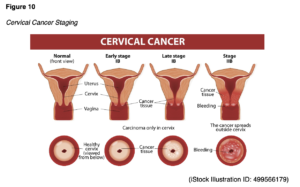Cervical cancer is one of the leading causes of death among women. Every woman must be aware of these disorders.
What Is Cervical Cancer?
Cervical cancer is a form of cancer that develops at the lower end of the uterus, where it meets the upper vagina, known as the uterine cervix. Due to a lack of access to screening and immunizations against human papillomaviruses, cervical cancer is a leading cause of death in women in the majority of underdeveloped countries (HPVs). Call and book your appointment with Dr.Amita Shah’s Global Women’s Clinic.

Cervical Cancer Causes
Long-term infection with one of the papillomaviruses is the most common cause of cervical cancer (HPV). HPV infection is frequent, although not all cases of HPV infection result in cancer. There are over 100 different forms of HPV, and just a few of them have been related to cancer. Other HPV kinds, on the other hand, typically generate benign warts on the genitals or skin. High-risk In men, HPV has been linked to cervical and penile malignancies.
Cervical Cancer Signs and Symptoms
Cervical cancer may not produce any symptoms at all, especially in its early stages. When cancer cells begin to attack surrounding tissues, symptoms may occur. Abnormal vaginal bleeding, longer or heavier menstrual periods than usual, vaginal bleeding after sex, pain during sexual intercourse, and other abnormal vaginal discharge are some of the indications and symptoms.

Risk factors
Some risk factors, however, may enhance the likelihood of acquiring cervical cancer. These are some examples:
- HPV: This is a virus that is spread by sexual contact. There are about 100 different strains of HPV, at least 13 of which can cause cervical cancer.
- Cigarette smoking: This raises the risk of cervical cancer and other forms.
- A compromised immune system: People with HIV or AIDS, as well as those who have had a transplant, are more likely to develop cervical cancer, which necessitates the use of immunosuppressive drugs.
- Birth control medications: Long-term usage of several common contraceptive pills boosts a woman’s risk marginally. Other sexually transmitted infections (STDs) that raise the risk of cervical cancer include Chlamydia, gonorrhoea, and syphilis.
- Socioeconomic status: Rates appear to be greater in low-income communities.
What Are the Different Stages of Cervical Cancer?
The stage of any cancer refers to how far it has spread in the body at the time of diagnosis. Cancer staging is important in selecting the optimal treatment option.
Cervical cancer progresses through the following stages:
- 0th stage: The malignancy is not yet completely invasive at this stage. As with CIN 3, the abnormal cells are only on the cervix’s surface. This stage is known as carcinoma in situ (CIS).
- Stage I: A small amount of tumour is present but has not migrated to any lymph nodes or distant places.
- Cancer has spread beyond the cervix and uterus but has not penetrated the pelvic walls or the lower region of the vagina.
- Stage III: cancer has spread to the pelvic walls or the lower region of the vagina. A tumour could be obstructing the urethras. However, it has not spread to other parts of the body.
- Stage IV: The most advanced stage, in which cancer has spread to other parts of the body such as the bladder and rectum.

Treatment for cervical cancer
Cervical cancer is often treatable if detected early. The four primary therapies are as follows:
- (i). surgery
- (ii). ionizing radiation treatment
- (iii). chemotherapy
- (iv). specialised treatment
These therapies are sometimes combined to improve their efficacy.
Surgery
The goal of surgery is to remove as much cancer as possible. The doctor may be able to remove only the portion of the cervix containing cancer cells. For more advanced cancers, surgery may include the removal of the cervix and other pelvic organs.
Radiation treatment
Using high-energy X-ray beams, radiation kills cancer cells. It can be administered by a machine located outside the body. It can also be given from within the body by inserting a metal tube into the uterus or vagina.
Chemotherapy
Chemotherapy is a treatment that employs chemicals to kill cancer cells throughout the body. This treatment is administered by doctors in cycles. You will be subjected to chemo for a length of time. You will then discontinue treatment to allow your body to recuperate.
Therapy
Bevacizumab (Avastin) is a newer medication that operates differently than chemotherapy and radiation. It prevents the formation of new blood vessels, which aid in the growth and survival of cancer. This medication is frequently administered in conjunction with chemotherapy.
Surgery for cervical cancer
Cervical cancer is treated using a variety of surgical techniques. Which one your doctor advises is determined by the extent of the cancer’s spread.
- (i). Cryosurgery uses a probe implanted in the cervix to freeze cancer cells.
- (ii). A laser beam is used in laser surgery to burn away aberrant cells.
- (iii). Conization is the surgical removal of a cone-shaped piece of the cervix with a surgical knife, laser, or electrically heated thin wire.
- (iv). The entire uterus and cervix are removed during a hysterectomy. A radical hysterectomy is performed when the top of the vagina is also removed.
- (v). Trachelectomy removes the cervix and the top of the vagina, but leaves the uterus in situ, allowing a woman to conceive children later on.
- (vi). Depending on where cancer has spread, pelvic exenteration may include the removal of the uterus, vagina, bladder, rectum, lymph nodes, and a portion of the colon.
Cervical Cancer Prevention
Cervical cancer can be avoided with vaccination and the use of advanced screening procedures that detect precancerous alterations in the cervix. Gardasil and Gardasil 9 vaccines are available to protect against HPV, which causes cervical cancer. In addition, Pap testing to detect precancerous alterations that can be treated before they proceed to malignancy has lowered the number of incidences of cervical cancer in the developed world. Schedule your appointment today with Dr. Amita Shah who is the best gynae for women-uterine fibroids.
































